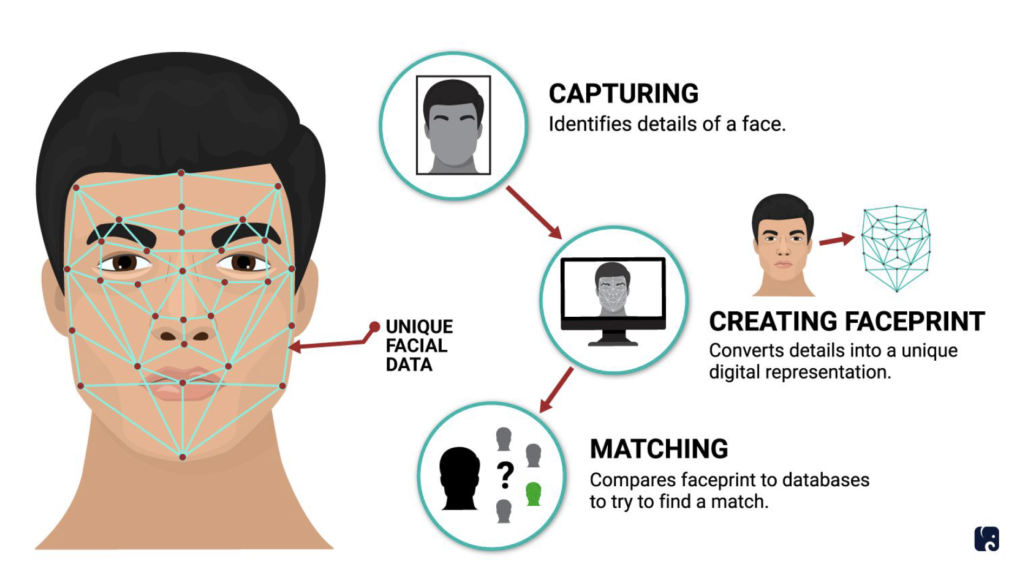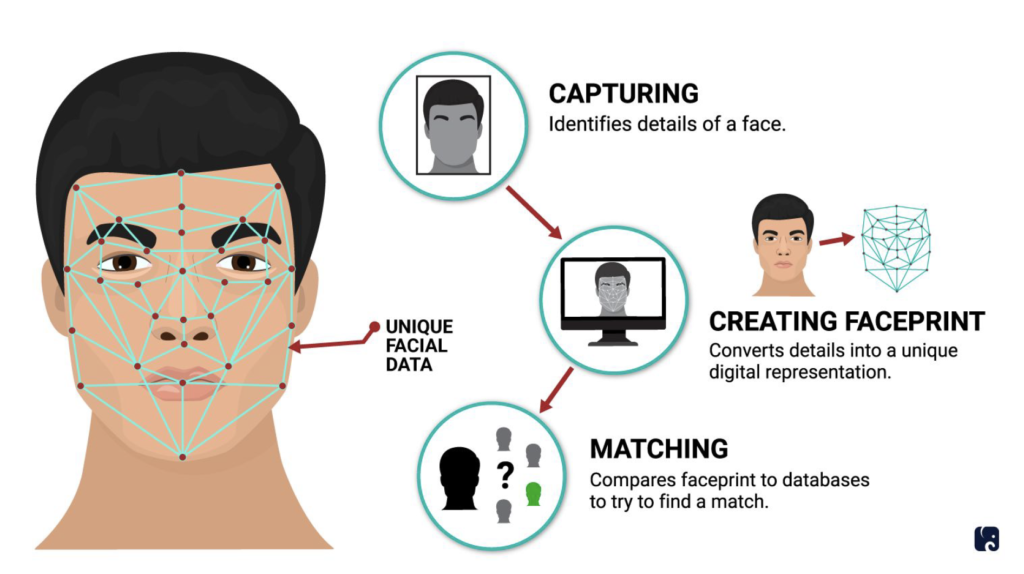Download the PDF of Factsheet: Facial Recognition Technology (FRT)
How It Works

Facial recognition technology is technology that claims to identify a person using their face.
FRT systems usually have 3 components: a camera, an algorithm, and a database. FRT may also be software only.
FRT algorithms are proprietary and vary slightly but essentially work the same way: By analyzing the unique pattern of a person’s face, then comparing the pattern to other images.
LAPD Use of FRT
- LAPD started using FRT in 2004 in the McArthur Park area[1] to “reclaim”[2] the park through heavy police presence, surveillance, and arrests. FRT has also been used in LAPD patrol cars[3] and CCTVs around the Jordan Downs and San Fernando Valley communities.[4]
- From 2009 to 2020, LAPD also used FRT third-party software, which was used in 2020 to investigate activities “that took place during summer protests over police shootings.”[5]
- LAPD has been evasive and deceptive about the use of FRT, and claims now only to use it through LASD’s Digital Mugshot System (DMS), which is a part of the Los Angeles County Regional Identification System, or LACRIS. LAPD has used LACRIS since 2012. Today 330 LAPD personnel have access to the system.[6]
- In 2020, LAPD is attempting to establish a policy[7] to use “Photo Comparison Technology (PCT)” within the DMS. The DMS contains approximately 9 million mugshots[8] and over 3 million images of peoples’ scars, marks, and tattoos.[9]
- LAPD can submit images to the DMS that have been “enhanced,” cropped, or adjusted. LAPD already has the technology to create a model of a person’s face[10] from a blurred video, and photo filters to “extract” tattoos.[11] Images manipulated in this way can still be submitted to FRT for analysis and a search for a “match.”
- With FRT search results, LAPD can create wanted posters, ‘Be On the Look Out’ (BOLOS) posters, and digital “suspect” line-ups. Police can also check the identification of folks against “hot lists” and create system alerts and notifications for future “matches” of an image or person.[12]
LAPD uses FRT to add and connect data points obtained through LAPD’s architecture of surveillance.
- FRT is not just an identification tool, but allows police to map relationships within people and communities as a part of surveillance and data mining (data mining is the process of looking for patterns and relationships in large groups of data, with the goal of making predictions about future events).
The Dangers of FRT
- FRT has bias,[13][14] with folks who are Black, women, trans, non-binary, and/or youth being most frequently misidentified. The risk of bias increases further when using a mugshot database, as the pool of folks is already skewed due to the disproportionate policing and incarceration of Black folks and folks who are queer and trans.
- Searching the DMS to find the “most similar” match also places undue attention on folks with previous experiences with police, and folks only look “most similar” to be suspected and potentially investigated.
- Police also confirm the technology has astoundingly high rates of failure. In Detroit, which uses the same technology provider (DataWorks Plus) as Los Angeles police, Detroit PD confirm that 96% of results are misidentifications.[15]
- FRT exposes folks in communities that are already heavily policed to additional risk and attention, which is traumatic and deadly.
Cities Have Banned FRT
Facial recognition technology has been banned in Alameda, CA; Berkeley, CA; Jackson, MS; Oakland, CA; Portland, ME; Portland, OR; and San Francisco, CA.[16]
We Demand An Outright Ban of FRT by LAPD!
LAPD is seeking approval from the Los Angeles Police Commission for a new policy[17] authorizing police use of face recognition surveillance, yet we need only search recent history for instances when LAPD was exposed for breaking policy and/or state law:
- October 2020: An audit of LAPD’s stop data reveals unauthorized searches in nearly 25% of stops, impacting tens of thousands of people.
- June 2020: An investigation is launched into LAPD use of excessive force against community members during the uprisings.[18]
- January 2020: Investigation into Metro officers falsifying Field Interview (FI) card data for entry into “gang” databases grows to 20 officers.[19]
- September 2019: LAPD revealed to have used FRT nearly 30,000 times since 2009, while repeated responses to California Public Records Act (CPRA) requests say otherwise.[20]
- April 12, 2019: LAPD shuts down Operation LASER, a program spanning 16 divisions, after an audit revealed wide-spread violations of people’s rights.[21]
Even when policy is established, mission creep is guaranteed and use expands over time, and this is by design. LAPD cannot be trusted regardless of what policy is in place, or what amount of “oversight.”
We demand an end and total ban on the use of facial recognition by LAPD. We remain committed to our fight to defund, dismantle, and abolish the LAPD and the entire architecture of surveillance.
[1] LAPD Uses New Technologies to Fight Crime LAPD Online, February 1, 2005
[2] Returning the Alvarado Corridor/MacArthur Park to the Community, LAPD Online, March 4, 2010
[3] Los Angeles Police: The Beat, March 2007
[4] Forget the NSA, the LAPD Spies on Millions of Innocent Folks, LA Weekly, February 27th, 2014
[5] LAPD bans use of commercial facial recognition technology: report
[6] Report: LAPD used facial recognition nearly 30,000 times AP Article re. LA Times, Sept 21, 2020.
[7] The Use of Photo Comparison Technology Within the Los Angeles County Digital Mugshot System, Dec. 2020
[8] The LAPD has used facial recognition software 30,000 times since 2009, Engadget, September 2020
[9] COUNTY OF LOS ANGELES REQUEST FOR INFORMATION RFI NUMBER 535-SH
[10] CVI_FaceFusion3D Tutorial
[11] Cognitech® TriSuite14 Feature List, Cognitech, 2014
[12] LASD RFQ Digital Mugshot System, March 17, 2017
[13] New Research Reveals Facial Recognition Software Misclassifies Transgender, Non-Binary People, Forbes, 2019
[14] Face Recognition Technologies: Designing Systems that Protect Privacy and Prevent Bias, pgs 15-17
[15] Detroit Police Chief: Facial Recognition Software Misidentifies 96% of the Time, VICE, June 29, 2020
[16] Massachusetts lawmakers vote to pass a statewide police ban on facial recognition, December 1, 2020
[17] The Use of Photo Comparison Technology Within the Los Angeles County Digital Mugshot System, Dec. 2020
[18] LA Police Reassigns 7 Officers As It Investigates Complaints Of Excessive Force
[19] LAPD scandal over alleged gang framing swells to 20 officers, Jan 14th, 2020
[20] LAPD widely used controversial facial recognition software, Sept. 21, 2020
[21] LAPD ends another data-driven crime program touted to target violent offenders, April 12, 2019
